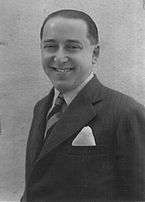Miklós Vig
| Miklós Vig | |
|---|---|
|
Miklós Vig | |
| Background information | |
| Birth name | Miklós Voglhut |
| Also known as | Miklós Vig |
| Born |
July 11, 1898 Budapest, Hungary |
| Origin | Hungary |
| Died |
December 19, 1944 (aged 46) Budapest, Hungary |
Miklós Vig was a Hungarian cabaret[1] and jazz[2][3] singer, actor, comedian[4] and theater secretary[1] in the 1920s, 1930s, and 1940s. Born in Budapest on July 11, 1898, he was murdered there on December 19, 1944 by members of the Arrow Cross.[5]
Background and Biography
Early life
He was born Miklós Voglhut[6] in 1898 to a Hungarian Jewish family in Budapest, Hungary.[1] Although he went to acting school, he had better success as a cabaret singer. In 1924 as his career was picking up he changed his surname to Vig.[6] He changed his name because Voglhut was a Jewish-sounding name and antisemitism was growing at the time. Vig means cheerful or merry; it is a nice, short, typically Hungarian name that also made a great stage name.[6]
Family
Other musicians from the Vig family include saxophone and clarinet player György Vig[3] (brother) and jazz musician Tommy Vig (nephew).[7]
A nephew of Miklós Vig, Dr. John R. Vig, was president of the IEEE in 2009.
Murder
The fact that he was married to a Catholic woman, Kati Szőke, and the fact that he changed his name did not save him from the Holocaust. On December 19, 1944, Miklós was among a group of Jews who were bound, lined up along the banks of the Danube and machine-gunned into the river[8] by Hungarian Nazis, members of the Arrow Cross Party. The Shoes on the Danube Promenade honors the memory of those who were murdered in this fashion.
Music and Comedy
He was a student of Géza Boross and his talent was discovered by Dezső Gyárfás and Antal Nyáray.
He had his first major successes at the Intim Kabaré as a soloist, and later performed frequently in other cabarets including the Budapest Operetta Theatre and Budapest Orfeum. Although he made many recordings, he became most famous as a singer of popular music on the radio.[1] A 1935 article in Színházi Élet describes Miklós as a singer of popular sentimental songs.[9]
According to Gramofon (the Hungarian Jazz and Classical music magazine), Miklós was considered part of the first generation of recorded Hungarian musicians.[10] When Deutsche Gramophone found themselves falling behind the competition, they signed Miklós who ultimately became their first dance-music star "beloved all around the country." [10]
As a comedian, he performed in the early 1920s at various cabarets including the Rakéta Kabaré - occasionally with female partner Annus Nagy.[4]
Discography
References
- 1 2 3 4 Hungarian Electronic Library (Hungarian)
- ↑ The JAZZ Discography
- 1 2 Magyar Jazzkutatási Társaság (Hungarian)
- 1 2 SzocHáló Társadalomtudomány (Hungarian)
- ↑ Yad Vashem A Page of Testimony
- 1 2 3 Voglhut Family History, by Imre Voglhut, unpublished
- ↑ All About Jazz
- ↑ Eye-witness testimony of a girl (name?) who saw what was happening and jumped into the river to get away - she then informed the surviving family.
- ↑ Ökotáj Színházi Élet, 1935. 32. szám (Hungarian)
- 1 2 Gramofon – Klasszikus és Jazz 1997.10.01 by Oldal Gábor (Hungarian)
- 1 2 3 4 5 Discographie der österreichischen Populärmusik Erfassung österreichischer Tanz-, Jazz- und U-Musikaufnahmen 1900 - 1958
- 1 2 3 4 Hungarian Jazz Discography 1905-2000 by Géza Gábor Simon, Budapest, 2005. ISBN 963-219-002-5
